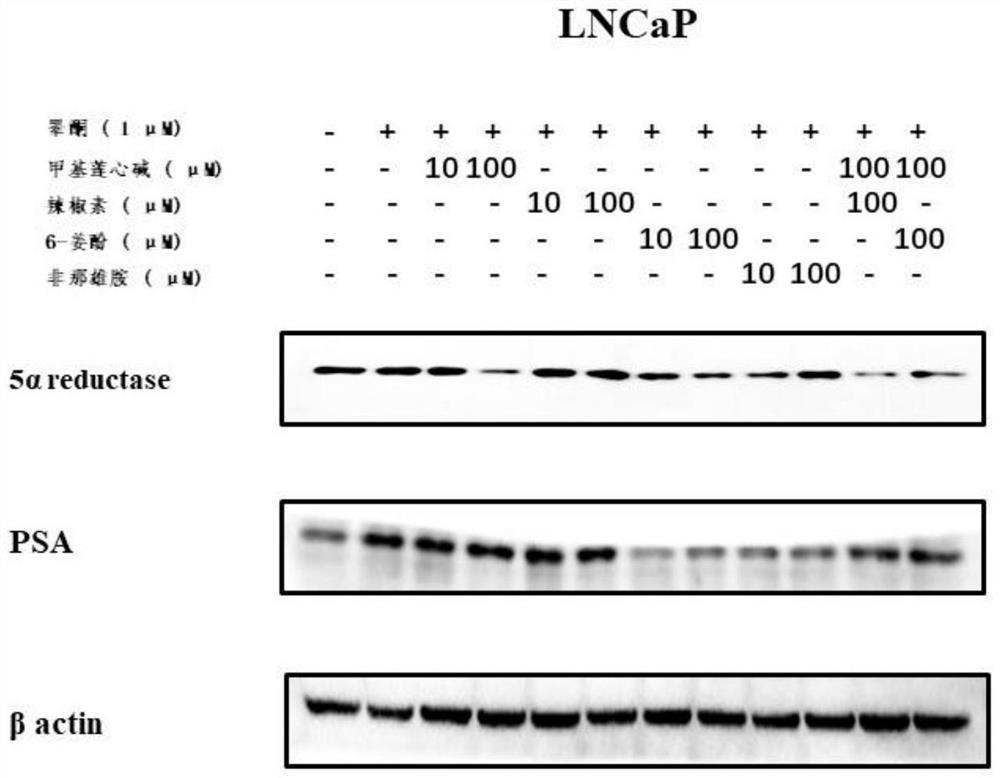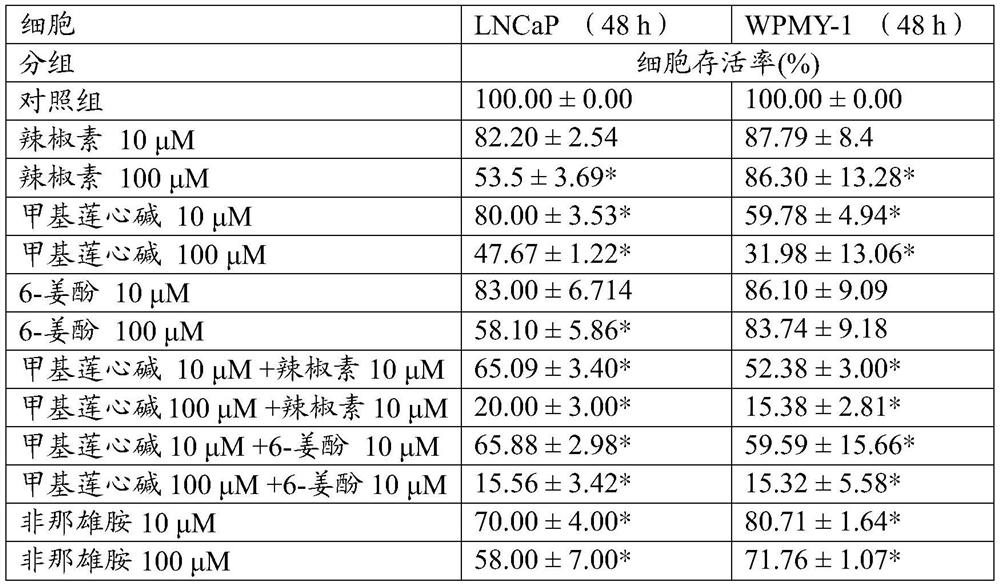Medicine prepared from neferine, capsaicin and 6-gingerol and used for inhibiting benign prostatic hyperplasia and application
A technology of liensinine and benign prostatic hyperplasia, which is applied in the field of biomedicine, can solve the problems of less therapeutic drugs and less research, and achieve the effect of improving local microcirculation
- Summary
- Abstract
- Description
- Claims
- Application Information
AI Technical Summary
Problems solved by technology
Method used
Image
Examples
experiment example 1
[0026] Experimental Example 1 Anti-Prostate Cell Proliferation
[0027] The purpose of this experiment example is to verify that capsaicin 10 μM, 100 μM, 10 μM, 100 μM of liensinine, 10 μM, 100 μM of 6-gingerol have anti-proliferative effects on prostate cells through cell experiments. All drugs were dissolved in dimethyl sulfoxide solution and added to the culture medium, the concentration of dimethyl sulfoxide solution was lower than 0.1%, v / v. Human prostate epithelial cell line LNCaP and human normal prostate stromal cells WPMY-1 were cultured in a 96-well plate with appropriate cell culture medium at 37°C in 5% CO 2 Incubate for about 48 hours under the same conditions, and add drugs after the cells attach and grow on the culture plate. LNCaP cells were incubated in RPMI-1640 medium, and WPMY-1 cells were incubated in DMEM medium.
[0028] The drug addition experiments were divided into 9 groups: (1) control group, containing only the medium and corresponding cells, wit...
experiment example 2
[0035] Experimental Example 2 Proliferation of Prostate Cells Induced by Antiandrogen
[0036] The purpose of this experiment example is to verify that capsaicin 10 μM, 100 μM, 10 μM, 100 μM of liensinine, 10 μM, 100 μM of 6-gingerol have anti-proliferative effects on prostate cells through cell experiments. All the drugs were dissolved in dimethyl sulfoxide solution and added to the culture medium, the concentration of dimethyl sulfoxide solution was lower than 0.1%, v / v. Human prostate epithelial cell line LNCaP and human normal prostate stromal cells WPMY-1 were cultured in a 96-well plate with appropriate cell culture medium at 37°C in 5% CO 2 Incubate for about 48 hours under the same conditions, and add drugs after the cells attach and grow on the culture plate. LNCaP cells were incubated in RPMI-1640 medium, and WPMY-1 cells were incubated in DMEM medium. It should be noted that when the above drugs are added, the stock solution is first prepared at a concentration eq...
experiment example 3
[0044] Experimental example 3 Antiandrogen induces expression of 5α-reductase and PSA protein in prostate epithelial cells
[0045] In the process of benign prostatic hyperplasia, 5α-reductase converts testosterone into more active dihydrotestosterone, and if the expression of 5α-reductase is effectively reduced, it can inhibit the proliferation of prostate cells. According to the experimental method of Example 1, capsaicin (10 μM, 100 μM), liensinine (10 μM, 100 μM), 6-gingerol (10 μM, 100 μM), and liensinine (100 μM) were combined with 6-gingerol ( 100 μM) and capsaicin (100 μM) acted on LNCaP cells, extracted cell protein 24 hours later, detected the expression of 5α-reductase and PSA protein in the cells, and evaluated the effect of the compound on inhibiting androgen-induced prostate cell proliferation by regulating the expression of the two proteins.
[0046] figure 1 It is the protein level expression diagram of 5α-reductase and PSA protein after prostate epithelial ce...
PUM
 Login to View More
Login to View More Abstract
Description
Claims
Application Information
 Login to View More
Login to View More - R&D
- Intellectual Property
- Life Sciences
- Materials
- Tech Scout
- Unparalleled Data Quality
- Higher Quality Content
- 60% Fewer Hallucinations
Browse by: Latest US Patents, China's latest patents, Technical Efficacy Thesaurus, Application Domain, Technology Topic, Popular Technical Reports.
© 2025 PatSnap. All rights reserved.Legal|Privacy policy|Modern Slavery Act Transparency Statement|Sitemap|About US| Contact US: help@patsnap.com



